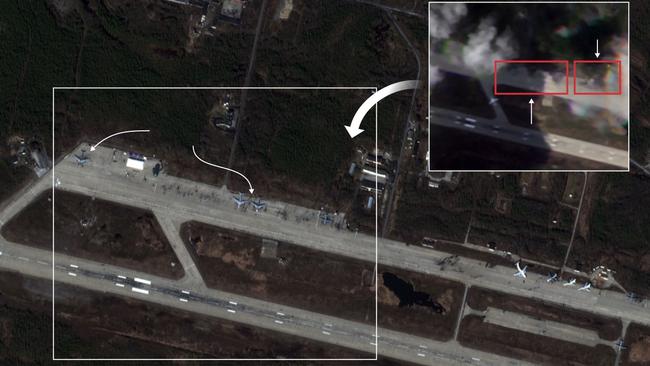Inside the Ukrainian drone operation that devastated Russia’s bomber fleet
Analysis reveals how homegrown tech and old-school spycraft were used in the attack, which started with a request to Kyiv’s spy chief as Russia’s air force pounded Ukraine’s power stations and cities with missiles, overwhelming meagre air defences.

Ukraine’s spectacular drone attack on Russia’s strategic bomber fleet on Sunday (local time) began with a daunting request from Ukraine’s president to his spy chief in late fall 2023.
The Russian air force was pommeling Ukraine’s power stations and cities with missiles, overwhelming meagre air defences, and Volodymyr Zelensky wanted to know: How can we fight back?
Lt. Gen. Vasyl Maliuk, a 42-year-old career security officer with broad shoulders and a stern mien, has earned a reputation for innovative operations with explosive naval and aerial drones that forced Russia to withdraw much of its Black Sea Fleet from its base in occupied Crimea and damaged dozens of oil plants and military-production facilities deep inside Russia.
But the task was formidable.
BREAKING: Ukraine has just released this nearly 5 minute video of their drones attacking numerous Russian military targets. What an incredibly well thought out plan. pic.twitter.com/tY7M2UinFc
— Brian Krassenstein (@krassenstein) June 4, 2025
The strategic bombers that launched many of Russia’s most powerful missiles operate from beyond the range of Ukraine’s air-defence systems, and were based at airfields across the country as much as 3,000 miles from Ukraine. Ukraine’s SBU security service, which Maliuk heads, has deployed long-range aerial drones effectively, but they are vulnerable to Russian air defences, including missile interceptors and jammers.
What Maliuk and his team came up with shocked the world on Sunday with its audacity. The agency smuggled Ukrainian drone parts into Russia and assembled them at a secret location. SBU operatives inside Russia used unwitting truck drivers to deliver a modern version of the Trojan horse by concealing the drones in the roofs of wooden containers. On Sunday, the roofs, activated remotely, slid open on trucks close to Russian airbases, releasing dozens of drones and adding a dash of Transformers to old-school spycraft.
More than 100 quadcopters, small drones with four rotors, emerged and zipped toward their targets, some descending through smoke billowing from already-damaged aircraft.
A Wall Street Journal analysis of official Ukrainian statements along with satellite images, accounts by people familiar with the operation, and photographs and videos posted on social media shows how a meticulously planned operation that combined homegrown technology with the classic art of deception unfolded.
Ukraine said that it damaged 41 warplanes valued at $7 billion at four bases using drones that cost about $2,000 each. Publicly available videos and satellite imagery reviewed by Journal showed 12 damaged planes across two airbases.
“The numbers the Ukrainians have been providing aren’t backed up yet by hard evidence,” said Sam Lair, a research associate at the James Martin Center for Nonproliferation Studies, a Monterey, Calif.-based think tank that studies weapons of mass destruction. Lair identified the damaged planes through satellite imagery and social media.
Olenya airbase

Still, he said, “It’s clear that this has dealt a very heavy blow to the Russian strategic bomber force, even if we aren’t seeing the numbers that the Ukrainians have claimed.” Of the four airbases that the SBU said it targeted, satellite imagery indicates that three sustained damage, and only two show visible signs of damaged aircraft — the Belaya and Olenya airbases.
Satellite imagery from Monday shows that a third airbase, Dyagilevo, sustained only a patch of burned grass, according to Lair.
Much of the damaged equipment is irreplaceable or hard to rebuild. A Ukrainian law-enforcement official said at least one of the targets damaged was a rare A-50 plane, which provides airborne early warning of potential threats and targets as well as command and control of the battlefield. Available satellite imagery doesn’t show any damaged A-50s.
Most of the planes hit were Tupolev Tu-95 bombers, a Soviet-era aircraft still crucial to Russia’s long-range missile campaigns. While the extent of the damage to Tu-95s remains unclear, in light of the aircraft’ age and scarcity of parts, even relatively minor damage could derail Russia’s air missions for months, Lair said.
Belaya airbase on June 2

Maliuk and his agency have plenty of experience striking prime targets, from the use of a truck bomb to damage the Kerch Bridge between mainland Russia and occupied Crimea to assassinations on Russian territory, including the killing of a Russian general with an exploding scooter as well as a bomb hidden in a statuette to kill a prominent war blogger.
Zelensky said that Ukrainian intelligence operatives in Russia had set up a base right under the noses of Russia’s Federal Security Service, the FSB. Russian law enforcement searched a concrete warehouse Sunday in Chelyabinsk, an industrial city in the Ural Mountains about 900 miles east of Moscow and a few miles from the local FSB headquarters, according to Russian media.
âš¡Russia's Olenya Air Base. pic.twitter.com/85XJz2l4K9
— OSINT Updates (@OsintUpdates) June 1, 2025
Russian state media named a Ukrainian DJ who had been living in Russia and recently relocated to the city last year as one of the people responsible for logistics behind the drone attack, purchasing the trucks that would carry the drones and co-ordinating the drivers. He didn’t respond to requests for comment.
Some of the materials the SBU used in the operation had to be smuggled across tightly controlled borders, including the parts that would eventually be assembled into the attack drones.
A Ukrainian law-enforcement official said the drones used were quadcopters called Osa, produced by the Ukrainian company First Contact. The craft, about the length of a man’s arm, are made in Ukraine, can carry a payload just over 7 pounds and travel at a maximum speed of just over 90 miles per hour, according to the manufacturer’s website.

Valeriy Borovyk, the founder of First Contact, declined to comment on whether the drones were used in the operation, but said they are manufactured for complex special operations.
Osa, Ukrainian for “bee,” has several alternatives for how it can be controlled. One of them is the ability to connect to cellular networks, which Russia shuts down when it expects an incoming strike but remain operational when there is an element of surprise, as there was with Sunday’s operation.
Borovyk said it was the SBU’s meticulous preparation ahead of the strike that would have allowed for drone operators to do their job effectively. He said the strike portion of the operation was the cherry on top.
“But this cake, they prepared it, cooked it, put it in a box, decorated it – to continue the metaphor – and all of this was done with great care and detail,” Borovyk said.

The truck drivers said to Russian authorities that they weren’t told about the contents of the containers and were instructed to stop at gas stations or roadside rest stops near the airports, according to Russian media.
Once parked at their designated locations, the roofs of the containers housing the quadcopters were opened remotely, the SBU said, and the drones flew out with a high-pitched buzz.
A photo shows Maliuk as he surveyed diagrams of planes where the most vulnerable spots are marked with red crosses. Justin Bronk, a senior research fellow at the Royal United Services Institute in London, said the crosses mark where internal fuel tanks are located on each type of plane, which would have caused a major fire when ignited by the small payload from the drones.
Celebrating the attack, Zelensky lauded the SBU — and personally thanked Maliuk — for the operation, which he said showed Ukraine is still in the fight.
“Russia’s whole narrative, which they spread everywhere, in Europe, in Britain, in America, that they’re safe, they’re winning the war – this narrative is not working,” Zelensky told reporters Monday. “They’re not safe.”
The Wall Street Journal






To join the conversation, please log in. Don't have an account? Register
Join the conversation, you are commenting as Logout